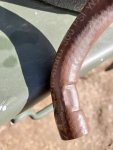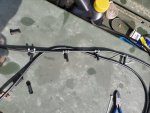- 2,941
- 7,166
- 113
- Location
- West greenwich/RI
Don't be fooled into thinking the leak is coming from the seal between the metering pump and the block. There is nothing there but motor oil. Your leak is likely a return line that is leaking down from up top and pooling up around the metering pumps and governor / throttle linkage.
Clean it up good and take the top cover off as LITD suggested, so you can get a good look at the injector area. Then with it clean and dry turn S1 to prime / run and watch for leaks while the machine is priming. Look especially at the 3.5mm return lines and all the T-fittings in the return line.
Also look at the rubber lines feeding the metering pumps, as well as the spring clamps where these hoses attach to the pumps.
If no leaks are found start the machine and do the same thing, looking closely at the metering pumps and injector lines.
Often times the wind from the fan and the vibration of the machine make things look different than they really are.
Clean it up good and take the top cover off as LITD suggested, so you can get a good look at the injector area. Then with it clean and dry turn S1 to prime / run and watch for leaks while the machine is priming. Look especially at the 3.5mm return lines and all the T-fittings in the return line.
Also look at the rubber lines feeding the metering pumps, as well as the spring clamps where these hoses attach to the pumps.
If no leaks are found start the machine and do the same thing, looking closely at the metering pumps and injector lines.
Often times the wind from the fan and the vibration of the machine make things look different than they really are.




